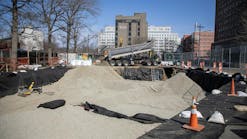EPA Pilots Effort in Three Massachusetts Communities to Reduce Storm Water Pollution
Source U.S. EPA
The U.S. Environmental Protection Agency (EPA) will require new measures to control storm water pollution in the Charles River watershed in Massachusetts. Under a pilot program that EPA is accepting public comments on, large industrial, commercial and multi-family residential facilities in three communities in the Upper Charles River Watershed will be required to reduce polluted runoff from their properties. This initiative is part of a continuing, multifaceted effort to restore the Charles to environmental health.
The EPA action will apply to properties with two or more acres of impervious area (parking lots, roofs, roadways, etc.) in the Towns of Milford, Franklin and Bellingham. These large property owners with two or more acres of impervious surfaces will now be required to obtain an EPA Clean Water permit, and to take steps to reduce pollutants in storm water.
Large impervious areas are one of the last major unregulated sources of water pollution and a chief culprit in dramatic algae blooms--including toxic cyanobacteria--that have plagued the Charles in recent years. Extensive impervious cover also aggravates the severity of flooding because those areas diminish the amount of land that can naturally soak in and filter rainwater.
The federal Clean Water Act mandates that storm water sources which degrade water quality below minimum standards be managed to reduce the harm they cause. Numerous studies have demonstrated a direct link between pollution in storm water and large impervious surfaces such as those coming under regulation with this permit.
Over the past dozen years, federal, state and local governments have invested hundreds of millions of dollars to clean up the Charles River, taking action to nearly eliminate sewer overflows, improve wastewater treatment plants and to clean up storm water.
“Today EPA is asking everyone to do their fair share to protect our most precious resource--a clean environment that supports healthy communities and a robust economy,” said Curt Spalding, regional administrator of EPA’s New England office. “This effort will spur creative thinking to develop appropriate green infrastructure to help capture storm water before it is channeled into our rivers, lakes and streams. EPA will provide maximum flexibility and a reasonable time-frame to ensure that together we all will protect the Charles.”
Currently, municipalities bear the burden for managing all of the storm water that flows from public and private properties through their storm drain systems. The proposed pilot program will shift some of that burden to the private properties such as mall parking lots and commercial and industrial office parks that shed substantial volumes of contaminated storm water through municipal pipes. Under existing regulations, virtually all of these facilities are not required to control storm water, even as municipal governments face tightened storm water requirements.
The permit is designed to encourage private property owners and municipalities to work together to produce a comprehensive approach to storm water management. Under the EPA program, property owners can choose to control their own storm water to specified standards, or can work with their town government on a community-wide approach. Facilities can choose from a simple menu of storm water controls, and receive specified credits to meet their reduction requirement. Analyses conducted by EPA and the Massachusetts Department of Environmental Protection indicate that municipal-wide programs will produce greater benefits at lower costs.
Source: U.S. EPA






